Which bathtub is better to choose - evaluation of all types!
In the 20th century, baths, basins, troughs and natural ponds were replaced by showers and baths. Moreover, their functions are not limited to hygiene. A long hot bath with fragrant soap is the most affordable and popular way to relieve fatigue after a long day.
And since, depending on household conditions, it can be used for bathing pets, and for soaking textiles in bleach, and for scalding mushrooms before pickling, and even for an impromptu date, choosing a bath is not the easiest thing.
To understand which bathtub is best to choose, you should answer three questions: how it will be used, how much space can be allocated for it, and what budget you need to meet. The answers will allow you to choose two or three options. The key parameter by which they differ is their material, so it is worth learning more about the materials.
Choosing a cast iron bath
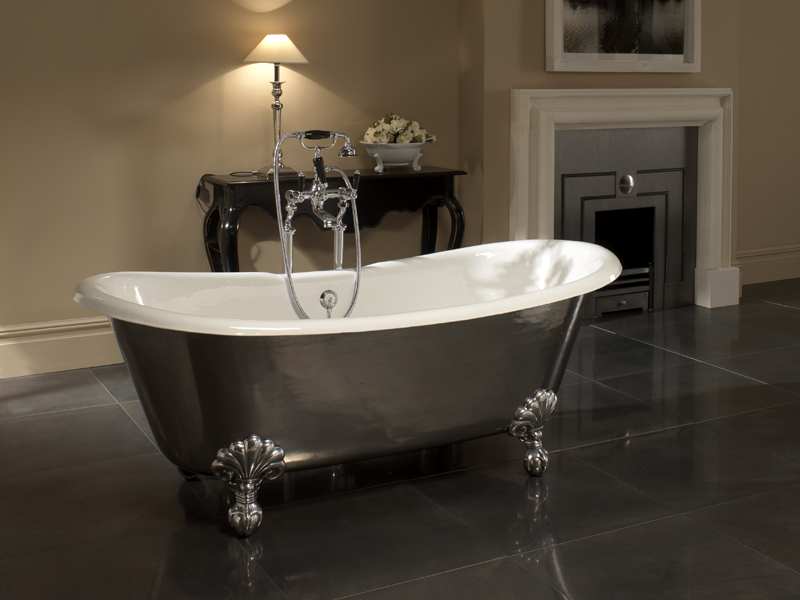 For many decades, cast iron was the only material from which home baths were made (unless, of course, you count the pre-revolutionary wooden and copper portable “bathing troughs”).
For many decades, cast iron was the only material from which home baths were made (unless, of course, you count the pre-revolutionary wooden and copper portable “bathing troughs”).
Although this metal cannot be called economical and convenient from a construction point of view, they are still very popular.
They are characterized by strength and durability, as well as the pleasant property of cooling slowly - in such a bath the water remains hot for a couple of hours. True, in a modern metropolis this advantage has lost its former meaning - adding hot water to an apartment with a central water supply is not a problem.
Their disadvantages include their heavy weight. Firstly, it is difficult to carry and mount. Secondly, it is difficult to deliver from abroad, and domestic manufacturers offer only a standard “rectangular” shape and strictly defined sizes. Thirdly, you need to carefully check the fastenings.
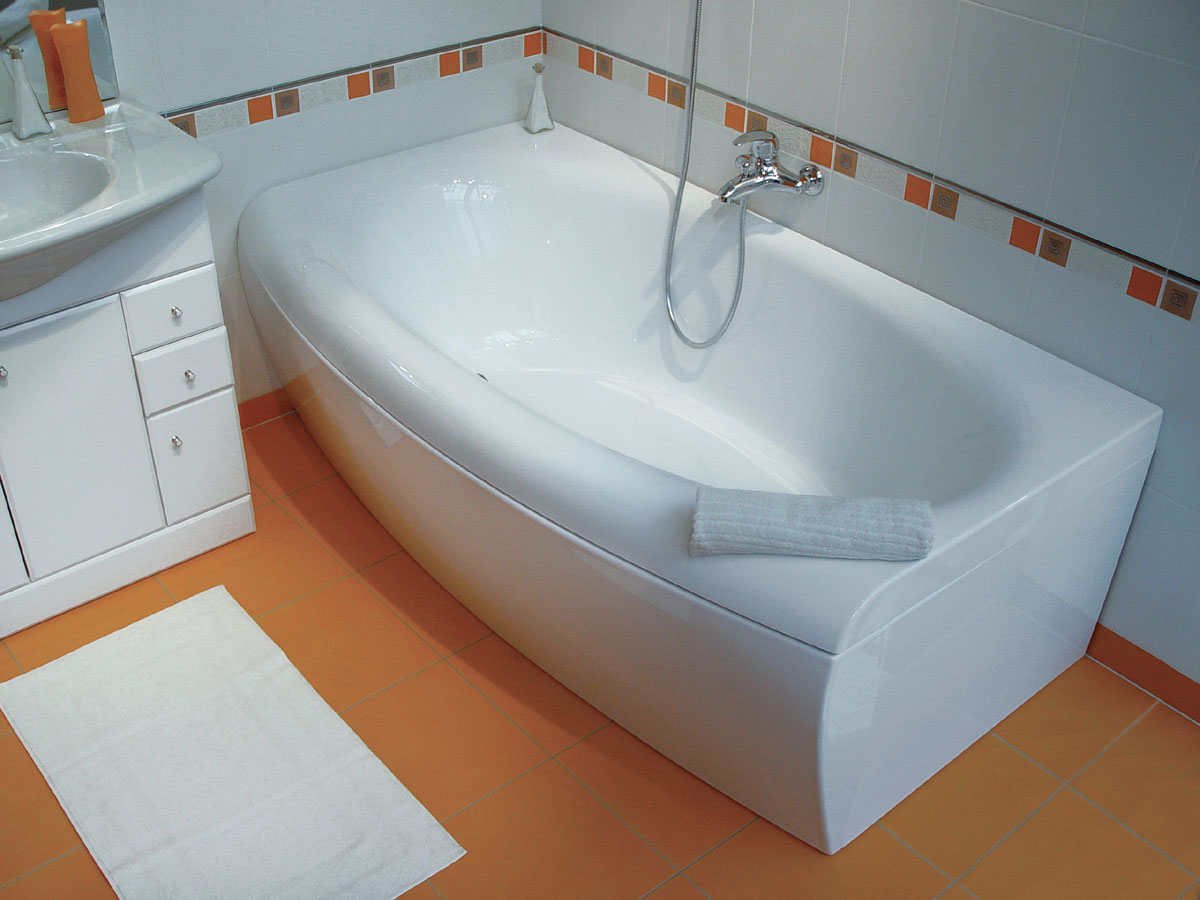
cast iron bathtub how to choose
If this is not done - or if the house's partitions are too thin and the floor can sag under the heavy weight - the bathtub may become slightly warped over time.
In this case, the edge will move away from the tile, or vice versa, “cut into” it.
Accordingly, either water will flow down the wall under the bathtub, which will most likely lead to the appearance of mold in a hard-to-reach place, or the tile will begin to crack - and it will be very difficult to replace it.
The enamel of cast iron bathtubs also requires special attention. It cannot be cleaned with caustic abrasives - this will expose the lower, reddish-gray layer of the coating. When a heavy object falls, chips can form on the enamel, which are almost impossible to restore. .
How to choose steel bathtubs?
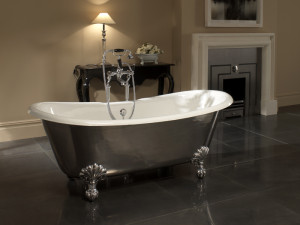 Another metal that is used in the manufacture of bathtubs is steel.
Another metal that is used in the manufacture of bathtubs is steel.
It is much lighter and more ductile than cast iron, so steel bathtubs come in all sizes and shapes.
Taking into account their durability, low cost and the ability to choose any enamel color, they are well suited for the budget implementation of an original design project.
However, there are a number of serious drawbacks. Firstly, the water cools quickly. If there is a central water supply, this problem is not particularly significant; it is much worse that when water is drawn, the steel “rings” quite loudly. If the walls are not thick enough, it may gradually begin to deform under the weight of water.
However, the problems are quite easily solved. It is only necessary to provide for its installation “in a monolith” - a supporting and heat-insulating podium. Such podiums are made of foam plastic with noise-damping rubber linings and a rigid frame, and ensure long and reliable service of the steel bathtub.
Video - which bathroom to choose (it’s better to watch it so you don’t make a mistake later and choose the required type and shape):
Acrylic - how to choose?
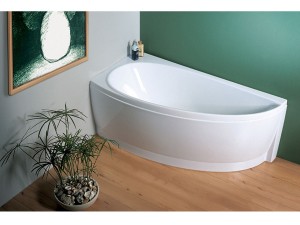 Acrylic is a polymer that can be formed into any shape, size and color. Coloring occurs when it melts, that is, acrylic baths do not have a coating that could wear off.
Acrylic is a polymer that can be formed into any shape, size and color. Coloring occurs when it melts, that is, acrylic baths do not have a coating that could wear off.
Any scratches and stains (which appear quite often) can be easily removed; you just need to paint them over with special paint and “polish” them with fine sandpaper.
It is not afraid of caustic abrasives and is easy to clean, durable, weighs little and retains heat for a long time. Thanks to these advantages, they are gaining more and more popularity.
However, acrylic itself is a plastic that melts and deforms when exposed to high temperatures. To avoid deformation, they are reinforced, ideally with a metal mesh, or in cheaper options with several layers of fiberglass.
How to choose an acrylic bathtub that will not “crawl” in a couple of years? Firstly, if it is strong, it should “sound” dull and quiet when tapped. Secondly, when reinforced with fiberglass, layers are visible on the edge of the side - the more there are, the better.
It costs more than cast iron and steel, so you should be suspicious of an inexpensive acrylic bathtub that catches your eye in a hardware store. Most likely, this is a fake made of plastic with an acrylic coating. Such types do not differ in high quality either in terms of thermal insulation or strength characteristics.
Video lesson - what you need to know when buying an acrylic bathtub:
Quarilic
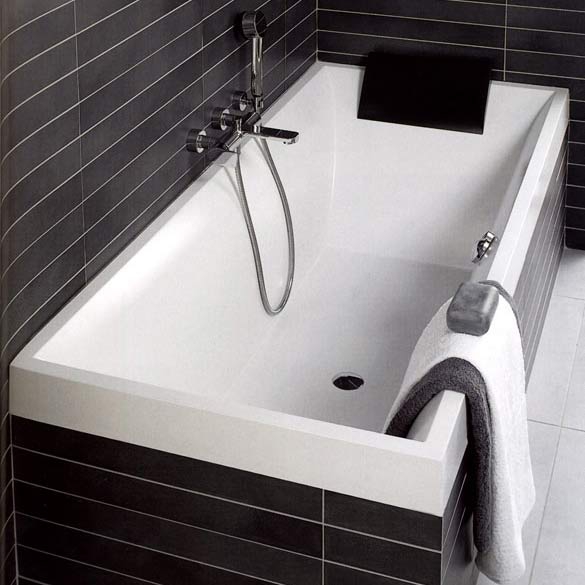 Although acrylic can be molded into any shape, the thicker the original sheet of acrylic, the less flexible it is.
Although acrylic can be molded into any shape, the thicker the original sheet of acrylic, the less flexible it is.
Therefore, bathtubs of complex shapes have thin walls. Meanwhile, it is the thickness of the wall that determines its reliability and durability.
If you need a complex shape, but don’t want to risk quality, you should pay attention to quaril. This is the same acrylic, only mixed with quartz chips.
In fact, quartz replaces reinforcement, and quite successfully. Quaril baths are varied, durable and scratch-resistant; their thermal insulation is no worse than that of acrylic ones, and they are only slightly heavier. The only disadvantage of the quaril is the high price.
Other materials
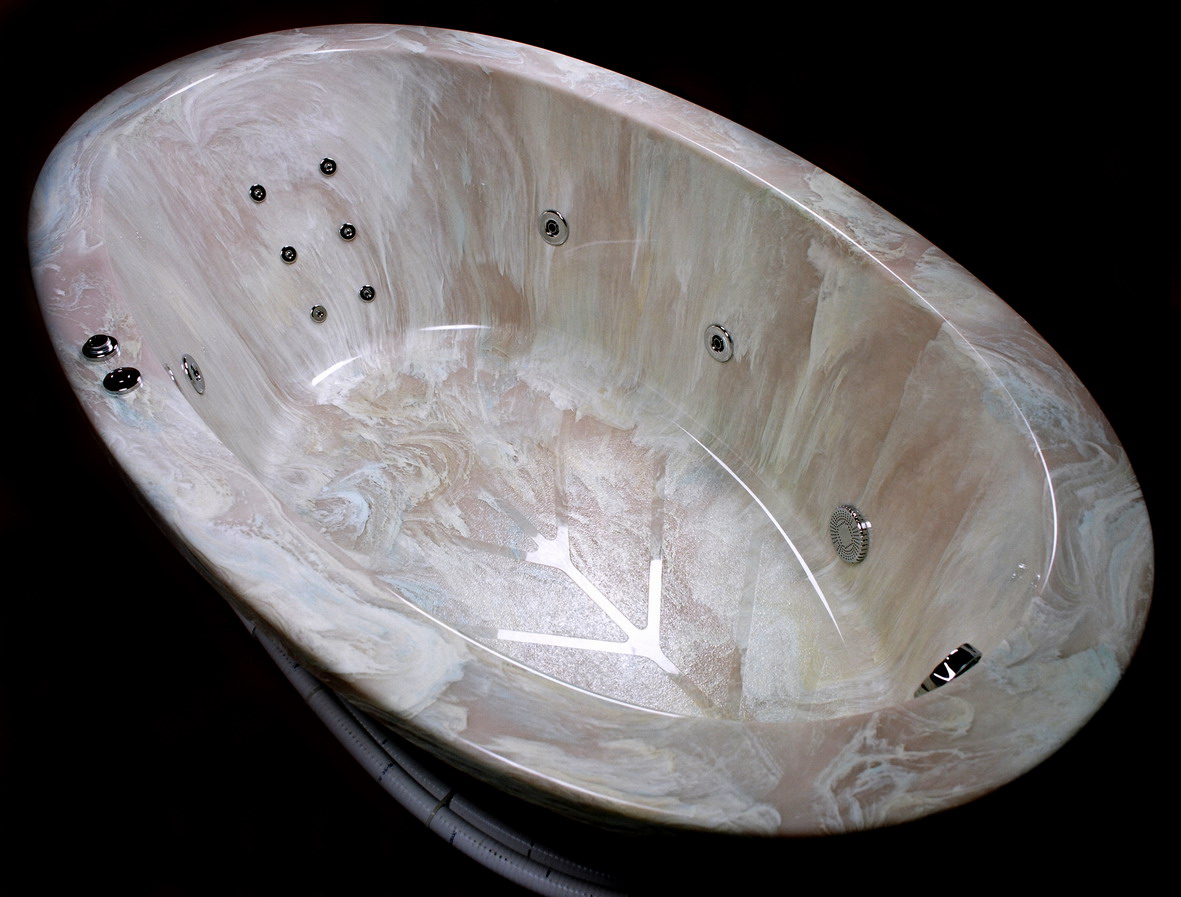 When designing and having a free budget, three more bathtub materials come into play - stone, glass and copper. All of them are rarely used due to their high cost and whimsicality.
When designing and having a free budget, three more bathtub materials come into play - stone, glass and copper. All of them are rarely used due to their high cost and whimsicality.
Stone and glass bathtubs, despite special treatment, due to which there is almost no risk of cracking, are susceptible to impacts and are easily chipped.
Copper is a plastic material that is easily deformed under the influence of hot water and the weight of the human body. In general, stone ones are more often used as built-in ones, usually mounted in the floor, while glass and copper ones are installed on frames that also perform artistic functions.
Hydromassage
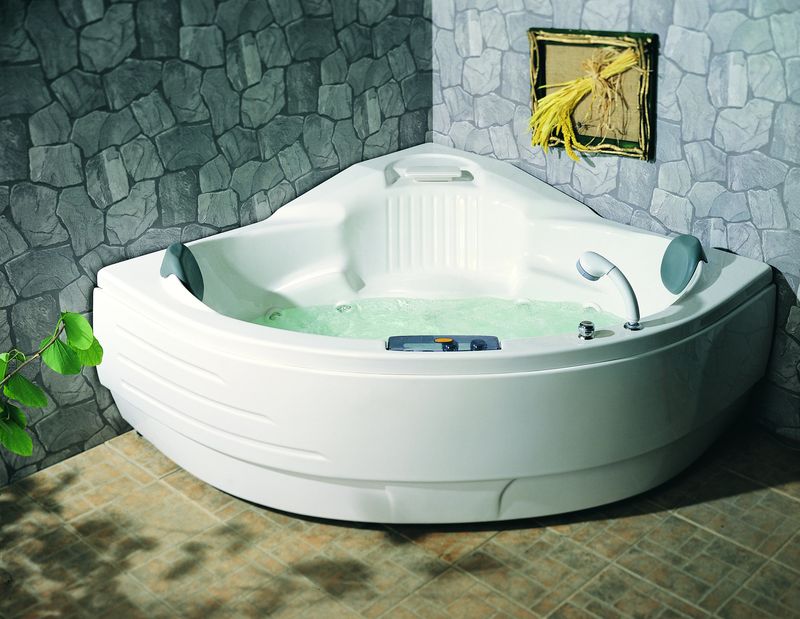 A bathtub with a hydromassage system is the choice of those who are often exposed to stress, sit for a long time in an uncomfortable chair and suffer from muscle pain, as well as those who simply love real comfort.
A bathtub with a hydromassage system is the choice of those who are often exposed to stress, sit for a long time in an uncomfortable chair and suffer from muscle pain, as well as those who simply love real comfort.
Hydromassage units include a small compressor, a motor and a system of pipes ending in wall-mounted nozzles. When turned on, compressed air or water is released from the nozzles under pressure, and 10-20 minutes of such a massage is enough for complete relaxation.
Hydromassage baths are most often made of acrylic; foreign manufacturers also offer them in steel and cast iron. The simplest ones have a pneumatic control system - the operating mode and intensity of the jets are set using mechanical levers. With electronic control, they also allow you to regulate the level and temperature of the water, set massage programs, and combine hydro and air massage.
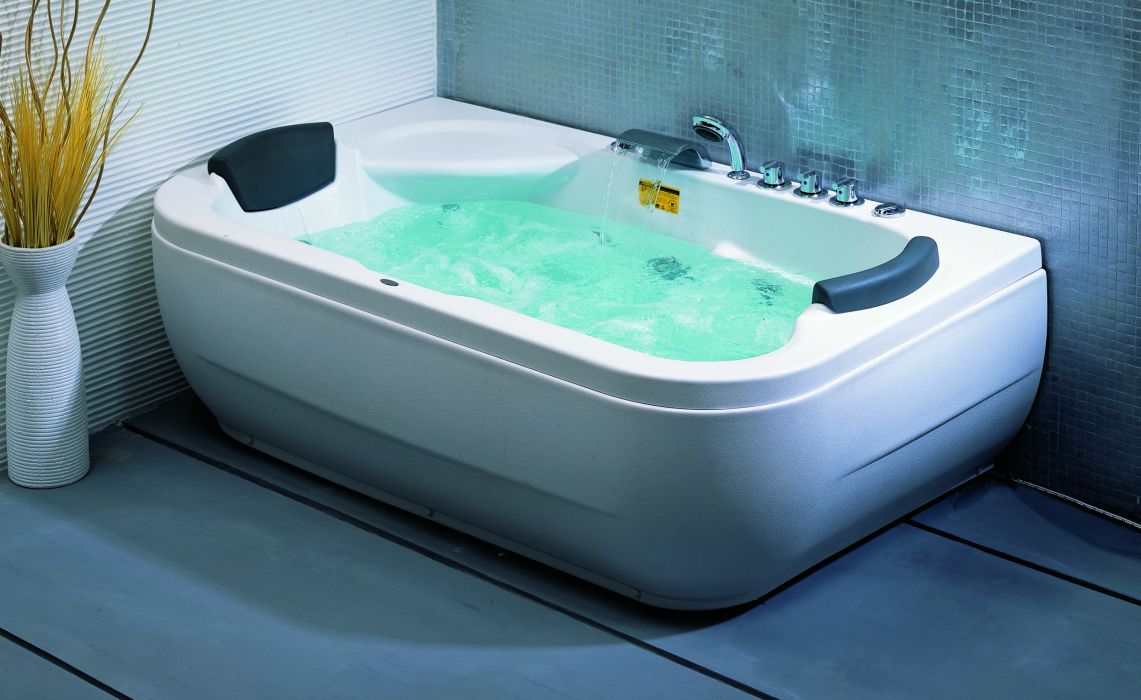
The number and location of nozzles may vary. A number of manufacturers of hydromassage bathtubs offer models with a medically justified arrangement of nozzles - opposite the neck, lower back and legs of a lying person.
Most often, the direction of the jets can change during a massage - this is provided by models with rotating nozzles.
They consume little energy and do not require special care - it is enough to pour a special disinfectant liquid into the system tubes once a month to avoid problems with sediments and microorganisms. Some have a drying system to prevent mold - this is useful if you plan not to use it, for example, during a vacation trip.
Bathtub dimensions - it’s better to know in person
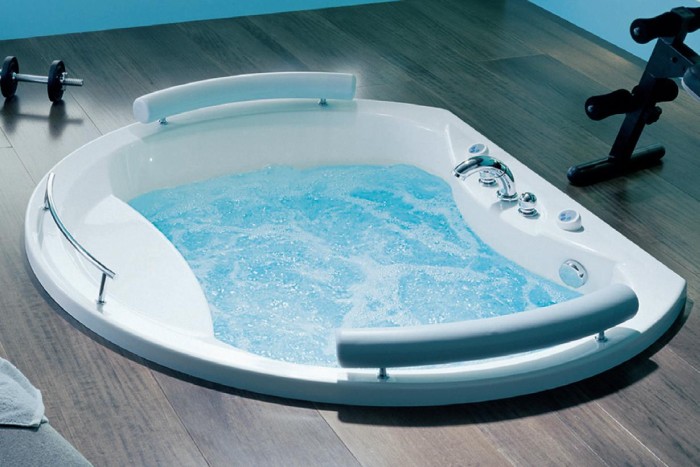 It is purchased mainly so that you can lie down in it and relax.
It is purchased mainly so that you can lie down in it and relax.
Therefore, the ideal size is determined experimentally. In addition, of course, it is worth considering in which room you plan to install the purchase.
Standard bath sizes are 150-180 cm in length, 70-85 cm in width and 50-65 cm in depth. Most bathrooms in houses built during Soviet times were designed under these parameters, so installation can almost always be done.
If you need to save on space, for example, when you also plan to install a washing machine, a laundry basket and a towel cabinet, what size bathtub is best to choose is one of the most difficult questions. In this case, you should pay attention to corner structures. They fit well into a small room, and are often more convenient than a short rectangular shape.
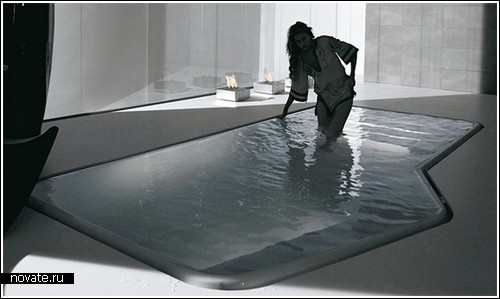 However, when choosing between rectangular acrylic and rectangular cast iron, you need to pay attention to the fact that with the same external dimensions they most often have different volumes.
However, when choosing between rectangular acrylic and rectangular cast iron, you need to pay attention to the fact that with the same external dimensions they most often have different volumes.
This is due to the fact that acrylic ones are usually equipped with internal armrests and a headrest. What is more necessary – these additions or an extra few liters of volume – is a matter of taste.
Today's plumbing market offers many non-standard, but useful and relevant options. In addition to plumbing fixtures of unusual shapes, there are rectangular ones, which differ from the usual ones only in double the width and two headrests - for two people. Hydromassage systems sometimes come with water lighting, which makes evening relaxation even more relaxing. Models with anti-slip coating and handles are useful for renovations in the apartments of elderly people.
Which bathtub is best to choose is up to the owners to decide together with the builders. Regardless of the budget and conditions, the disadvantages of any material and dimensions can be turned into advantages - it is better to take care of this in advance.






